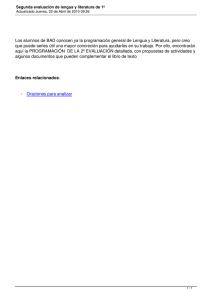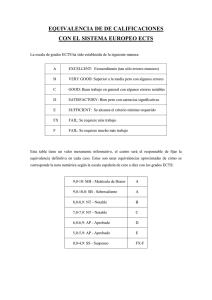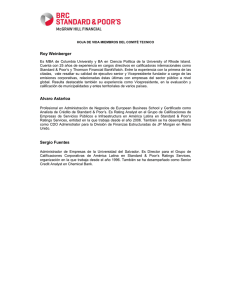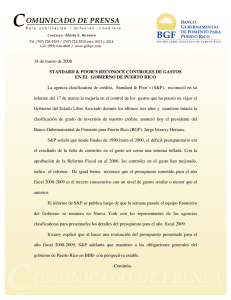Master in Economics and Finance Sistema de garantía de calidad
Anuncio
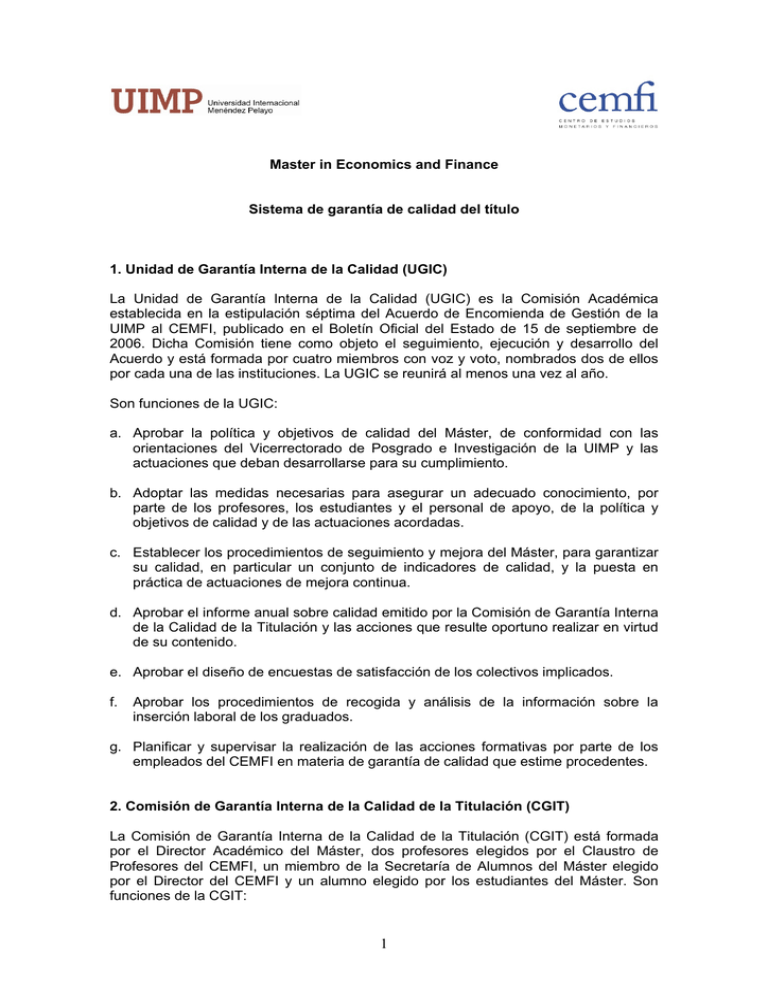
Master in Economics and Finance Sistema de garantía de calidad del título 1. Unidad de Garantía Interna de la Calidad (UGIC) La Unidad de Garantía Interna de la Calidad (UGIC) es la Comisión Académica establecida en la estipulación séptima del Acuerdo de Encomienda de Gestión de la UIMP al CEMFI, publicado en el Boletín Oficial del Estado de 15 de septiembre de 2006. Dicha Comisión tiene como objeto el seguimiento, ejecución y desarrollo del Acuerdo y está formada por cuatro miembros con voz y voto, nombrados dos de ellos por cada una de las instituciones. La UGIC se reunirá al menos una vez al año. Son funciones de la UGIC: a. Aprobar la política y objetivos de calidad del Máster, de conformidad con las orientaciones del Vicerrectorado de Posgrado e Investigación de la UIMP y las actuaciones que deban desarrollarse para su cumplimiento. b. Adoptar las medidas necesarias para asegurar un adecuado conocimiento, por parte de los profesores, los estudiantes y el personal de apoyo, de la política y objetivos de calidad y de las actuaciones acordadas. c. Establecer los procedimientos de seguimiento y mejora del Máster, para garantizar su calidad, en particular un conjunto de indicadores de calidad, y la puesta en práctica de actuaciones de mejora continua. d. Aprobar el informe anual sobre calidad emitido por la Comisión de Garantía Interna de la Calidad de la Titulación y las acciones que resulte oportuno realizar en virtud de su contenido. e. Aprobar el diseño de encuestas de satisfacción de los colectivos implicados. f. Aprobar los procedimientos de recogida y análisis de la información sobre la inserción laboral de los graduados. g. Planificar y supervisar la realización de las acciones formativas por parte de los empleados del CEMFI en materia de garantía de calidad que estime procedentes. 2. Comisión de Garantía Interna de la Calidad de la Titulación (CGIT) La Comisión de Garantía Interna de la Calidad de la Titulación (CGIT) está formada por el Director Académico del Máster, dos profesores elegidos por el Claustro de Profesores del CEMFI, un miembro de la Secretaría de Alumnos del Máster elegido por el Director del CEMFI y un alumno elegido por los estudiantes del Máster. Son funciones de la CGIT: 1 a. Elaborar el informe anual sobre calidad, que evaluará las actuaciones derivadas de la política y objetivos de calidad del Máster y deberá contener en todo caso análisis de los siguientes aspectos: 1) Los indicadores de calidad establecidos por la UGIC. 1. Tasa de graduación: Porcentaje de estudiantes que finalizan la enseñanza en el tiempo previsto en el plan de estudios o en un año académico más en relación con su cohorte de entrada. 2. Tasa de abandono: Relación porcentual entre el número total de estudiantes de una cohorte de nuevo ingreso que debieron obtener el Título el año académico anterior y que no se han matriculado ni en ese año académico ni en el anterior. 3. Tasa de eficiencia: Relación porcentual entre el número total de créditos teóricos del plan de estudios a los que debieron haberse matriculado a lo largo de sus estudios el conjunto de estudiantes graduados en un determinado curso académico y el número total de créditos en los que realmente se han matriculado. 4. Tasa de rendimiento: Relación porcentual entre el número de créditos ordinarios superados por los estudiantes en un determinado curso académico y el número total de créditos matriculados por estos los mismos. 5. Tasa de éxito: Relación entre el número de créditos superados por el total de estudiantes matriculados entre el número de créditos presentados por el total de estudiantes matriculados. 6. Notas: Media final, desviación típica y porcentajes de aprobados, notables y sobresalientes. 2) Las encuestas de satisfacción de los colectivos implicados. 1. Resumen de las encuestas trimestrales a los estudiantes: valoración media y desviación típica del conjunto de cursos en el primer año y el segundo año (Anexo 1). 2. Resumen de las encuestas anuales a los estudiantes: valoración de los cursos en el primer año y el segundo año y de los servicios proporcionados por el CEMFI (Anexo 2). 3. Informe sobre las prácticas de verano: lista de instituciones y valoración de los estudiantes y de las empresas e instituciones que los acogen (Anexo 3). 3) La inserción laboral de los graduados. 1. Informe sobre las salidas profesionales de los estudiantes: lista de instituciones y valoración de los graduados de la última promoción (Anexo 4). b. Poner en práctica las decisiones de la Unidad de Garantía Interna de la Calidad y llevar a cabo su seguimiento. 2 3. Procedimiento para el análisis de la satisfacción de los distintos colectivos implicados (estudiantes, personal académico y de apoyo) y de atención a las sugerencias y reclamaciones. a. Estudiantes: 1) Peticiones de revisión de la calificación de cada asignatura: Número medio por curso académico. 2) Creación de un buzón de sugerencias y reclamaciones a la Secretaría de Alumnos: Visible en la página web, pero remite a la intranet, con acceso limitado a los estudiantes. Resumen de las reclamaciones recibidas. b. Personal académico y de apoyo: 1) Resumen de las encuestas de satisfacción (Anexo 5). 2) Creación de un buzón de sugerencias y reclamaciones al Director. Visible en la página web, pero remite a la intranet, con acceso limitado a los estudiantes. Resumen de las reclamaciones recibidas. 3 Lista de anexos 1. Encuestas sobre las asignaturas 2. Encuestas sobre el año académico 3. Encuestas sobre las prácticas de verano 4. Encuestas a los graduados recientes 5. Encuestas a los profesores y el personal de apoyo 4 Anexo 1. Encuestas sobre las asignaturas MASTER IN ECONOMICS AND FINANCE COURSE SURVEY 1. Degree of interest of the course Very high High Fair Low None 2. Structure of the program Excellent Good Fair Poor Bad 3. How difficult are the lectures? Too difficult Difficult Adequate level Easy Too easy 4. How difficult are the problem set classes? Too difficult Difficult Adequate level Easy Too easy 5. Coordination of lectures and problem set classes Excellent Good Fair Poor Bad 6. Clarity of exposition Excellent Good Fair Poor Bad 5 7. Speed of presentation Too fast Fast Adequate Slow Too slow 8. Global assessment of the course Excellent Good Fair Poor Bad 9. Best features of the course 10. Worst features of the course 11. Other comments and suggestions 6 Anexo 2. Encuestas sobre el curso académico MASTER IN ECONOMICS AND FINANCE FIRST YEAR SURVEY 1. Indicate the courses of the first year that you liked the best and the reasons why (at least one, up to three) Course 1: [drop-down list] Course 2: [drop-down list] Course 3: [drop-down list] 2. Indicate the courses of the first year that you liked the least and the reasons why (at least one, up to three) Course 1: [drop-down list] Course 2: [drop-down list] Course 3: [drop-down list] 3. Evaluate the teaching methods of the first-year courses Excellent Good Fair Poor Bad 4. Evaluate the grading system of the first-year courses Excellent Good Fair Poor Bad 5. Evaluate the organization of the first-year curriculum Excellent Good Fair Poor Bad 6. Evaluate the coordination between first-year courses Excellent Good Fair Poor Bad 7 7. Evaluate the attention received from the full-time professors Excellent Good Fair Poor Bad 8. Evaluate the information and support received from your tutor Excellent Good Fair Poor Bad 9. Evaluate the facilities (i) Library Excellent Good Fair Poor Bad (ii) Computer facilities Excellent Good Fair Poor Bad (iii) Classrooms Excellent Good Fair Poor Bad (iv) Study areas Excellent Good Fair Poor Bad 8 10. Give your global assessment of the first year Excellent Good Fair Poor Bad 11. Comments and suggestions for the future 9 MASTER IN ECONOMICS AND FINANCE SECOND YEAR SURVEY 1. Indicate the courses of the second year that you liked the best and the reasons why (at least one, up to three) Course 1: [drop-down list] Course 2: [drop-down list] Course 3: [drop-down list] 2. Indicate the courses of the second year that you liked the least and the reasons why (at least one, up to three) Course 1: [drop-down list] Course 2: [drop-down list] Course 3: [drop-down list] 3. Evaluate the teaching methods of the second-year courses Excellent Good Fair Poor Bad 4. Evaluate the grading system of the second-year courses Excellent Good Fair Poor Bad 5. Evaluate the organization of the second-year curriculum Excellent Good Fair Poor Bad 6. Evaluate the coordination between second-year courses Excellent Good Fair Poor Bad 10 7. Evaluate the attention received from the full-time professors Excellent Good Fair Poor Bad 8. Evaluate the attention received from your Master thesis supervisor Excellent Good Fair Poor Bad 9. Evaluate the information and support received from your tutor Excellent Good Fair Poor Bad 10. Evaluate the facilities (i) Library Excellent Good Fair Poor Bad (ii) Computer facilities Excellent Good Fair Poor Bad (iii) Classrooms Excellent Good Fair Poor Bad 11 (iv) Study areas Excellent Good Fair Poor Bad 11. Evaluate the information and support received from the academic placement officer (fill out only if pursued further studies) Excellent Good Fair Poor Bad 12. Evaluate the information and support received from the professional placement officer (fill out only if joined the labor market) Excellent Good Fair Poor Bad 13. Give your global assessment of the Master’s second year Excellent Good Fair Poor Bad 14. Comments and suggestions for the future 12 Anexo 3. Encuestas sobre las prácticas de verano MASTER IN ECONOMICS AND FINANCE STUDENT SUMMER INTERNSHIP SURVEY 1. How long did your internship last (number of weeks)? [drop-down list: 1-12] 2. What was your monthly remuneration in euros (0 if none)? [space for a number: 0-9,999] 3. Indicate your degree of satisfaction with your internship Excellent Good Fair Poor Bad 4. Indicate your degree of satisfaction with the internship coordination at CEMFI Excellent Good Fair Poor Bad 5. Comments and suggestions on your internship 13 MASTER IN ECONOMICS AND FINANCE SURVEY OF FACULTY AND INSTITUTIONS INVOLVED IN SUMMER INTERNSHIPS 1. Indicate your degree of satisfaction with the internship coordination at CEMFI Excellent Good Fair Poor Bad 2. Evaluate the quality of the skills possessed by the student in relation to the requirements of the internship Excellent Good Fair Poor Bad 3. Indicate your degree of overall satisfaction with the internship Excellent Good Fair Poor Bad 4. Comments and suggestions for the improvement of the internships by CEMFI Master students 14 Anexo 4. Encuestas a los graduados recientes MASTER IN ECONOMICS AND FINANCE SURVEY OF GRADUATES IN WORK 1. Evaluate the teaching methods of the Master Excellent Good Fair Poor Bad 2. Evaluate the evaluation system of the Master Excellent Good Fair Poor Bad 3. Indicate your degree of satisfaction with the placement assistance received Excellent Good Fair Poor Bad 4. How many interview requests did you receive when you were looking for your first job (regardless of whether you attended them)? [drop-down list: 1-25 or more] 5. When did the job start? [space with dd/mm/yyyy] 6. Indicate your degree of satisfaction with the job Excellent Good Fair Poor Bad 7. Was your job in the private sector or in the public sector? Private Public 8. In what country was the job located? [drop-down list] 15 9. In what city was the job located? [space] 10. In what bracket was your total gross annual compensation in the job (including fixed salary, expected variable compensation, and other components of your remuneration)? Up to 30,000 euros Between 30,000 and 40,000 euros Between 40,000 and 50,000 euros Above 50,000 euros Note: Use market exchange rates to convert figures in other currencies. 11. Evaluate the degree of matching between the skills acquired in the Master and the requirements of the job Excellent Good Fair Poor Bad 12. Comments and suggestions for the improvement of the placement of the Master 13. Comments and suggestions for the improvement of the Master 16 MASTER IN ECONOMICS AND FINANCE SURVEY OF GRADUATES IN FURTHER STUDIES 1. Evaluate the teaching methods of the Master Excellent Good Fair Poor Bad 2. Evaluate the evaluation system of the Master Excellent Good Fair Poor Bad 3. Indicate your degree of satisfaction with the academic placement assistance received Excellent Good Fair Poor Bad 4. How many admission offers did you receive when applying to further graduate studies? [drop-down list: 1-25 or more] 5. Did the skills acquired in the Master correspond to the requirements of your further studies? Excellent Good Fair Poor Bad 6. Comments and suggestions for the improvement of the academic placement of the Master 7. Comments and suggestions for the improvement of the Master 17 Anexo 5. Encuestas a los profesores y el personal de apoyo MASTER IN ECONOMICS AND FINANCE FACULTY SURVEY 1. Indicate your degree of satisfaction with the coordination of the Master courses Excellent Good Fair Poor Bad 2. Indicate your degree of satisfaction with the Summer internships (only if you had a student intern) Excellent Good Fair Poor Bad 3. Indicate your degree of satisfaction with the results obtained by the students Excellent Good Fair Poor Bad 4. Evaluate the facilities (i) Library Excellent Good Fair Poor Bad (ii) Computer facilities Excellent Good Fair Poor Bad 18 (iii) Classrooms Excellent Good Fair Poor Bad 5. Indicate your degree of satisfaction with the resources provided by CEMFI for the Master program Excellent Good Fair Poor Bad 6. Comments and suggestions for the improvement of the Master 19 MASTER IN ECONOMICS AND FINANCE SUPPORT STAFF SURVEY 1. Evaluate the facilities (only if you are involved in the corresponding facility) (i) Library Excellent Good Fair Poor Bad (ii) Computer facilities Excellent Good Fair Poor Bad 2. Indicate your degree of satisfaction with the resources provided by CEMFI for the Master program Excellent Good Fair Poor Bad 3. Comments and suggestions for the improvement of the Master 20
